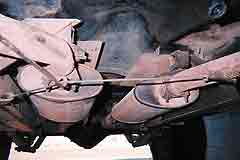Most of us don't give a second thought to exhaust systems until we hear strange noises from underneath our vehicle, pieces fall off or start dragging, or the vehicle fails an emissions test. Today's exhaust systems are made of much better materials so they can be expected to be trouble-free for five to seven years, longer if you live in a very dry climate, less where salt is liberally used on roads in winter.

If you suspect an exhaust system problem, if possible, raise the vehicle to get a better look. Indeed, it is a good idea to inspect the exhaust system any time you have to get under your car or truck. A lift works best, but you can use jack stands and ramps to provide more crawl space. DO NOT crawl under a vehicle until safely secured on jack stands. DO NOT depend on bumper jacks or use concrete blocks, which can break or crush. Let the exhaust system cool down before doing an inspection.
Mufflers and resonators are most likely to fail at welded connections or at seams where water condensation can cause rust. Also look for dents and other road damage. Hit the muffler with a rubber mallet and listen for rattles indicating loose baffles. Exhaust pipes can appear okay from the outside, but internal rusting can result in paper thin walls. Thus, check the condition of exhaust pipes using a pair of large channel lock pliers to perform a crush test. Replace deteriorated pipes. Inspect all hangers, clamps, heat shields and other components. Look for any exhaust system part that might be contacting or rubbing against the body or suspension. Discolored metal can indicate a leak.
After the visual inspection, start the engine and listen for leaks. Make sure the exhaust is vented outside to prevent carbon monoxide poisoning. Listen for leaks from the exhaust manifold, catalytic converter, muffler, resonator and connecting pipes, especially at the connection points. Have an assistant momentarily block the exhaust. This will often magnify any hissing or whistling to make detection easier.
Here are some tips that can make installing a new exhaust system less frustrating. If possible, do not disassemble the old system until you have all parts on hand. Compare all the new parts with the ones on the vehicle to insure they are all correct replacements. You might make a few notes and maybe even sketch the layout of the system. Assemble the entire system before tightening any clamps. This will let you jockey the various parts around to insure there is sufficient clearance between the exhaust system and the vehicle's suspension and body. If every thing checks out, tighten clamps and hangers, and then start the engine and check for leaks. Also do a road test. Find a bumpy road and listen for rattles, leaks or other noises.




